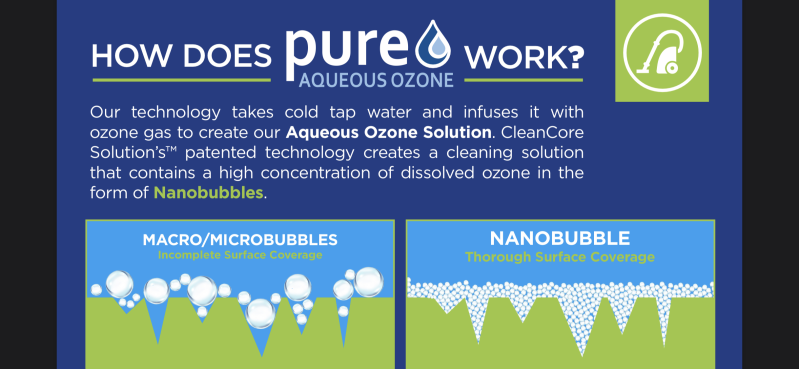
Nanotechnology reduces the size of the water molecules, creating three distinct advantages to non-nanotechnologies.
1 - more molecules per litre means means more atomic Oxygen released from the molecules to kill more germs faster.
2 - smaller molecules under pressure will retain the atomic Oxygen in the aqueous ozone solution making its effectiveness last longer (4 hours).
3 - smaller molecules are more easily able to get into microscopic crevasses in the surface being cleaned and sanitised.

Aqueous Ozone Cleaning
Different manufacturers and facilities managers have introduced aqueous ozone cleaning systems. However, many are not quite sure what aqueous ozone cleaning is all about. Here are some of the most commonly asked questions about aqueous ozone.
What is it?
Aqueous ozone is a powerful oxidizer proven to clean effectively, destroying a host of germs, bacteria, and other contaminants on surfaces, which helps to deodorize and sanitize them. Ozone is made up of three atoms found in the atmosphere and, as a result of new technologies, can be mechanically infused into water to create aqueous ozone, poured into a presurised sprayer, and used just like a traditional cleaning solution.
Is it safe?
Yes. Aqueous ozone is typically safer than traditional or green cleaning solutions. Users are advised to follow all standard safety precautions, including wearing gloves, as they would when using any cleaning solution. Many people then clean those gloves using aqueous ozone, so they are clean and sanitized for their next use.
Is it green?
Some aqueous ozone products are referred to as "greener than green" and have been certified by leading green certification organizations. Additionally, these systems promote sustainability. There are no boxes, packaging materials, or fuel required to transport aqueous ozone. The ozone is all made by one machine.
How long does it last?
After use, the water evaporates and the ozone reverts back to oxygen. Aqueous ozone does not leave chemical residue on surfaces.
How strong is it?
Aqueous ozone is often compared to chlorine bleach because it can be used in many similar disinfecting applications. While it is not an EPA-registered disinfectant and should not be used in place of a disinfectant, it does have "kill" rates comparable to the key ingredients found in most hospital-grade disinfectants. (While aqueous ozone can be compared to chlorine bleach, it does not corrode surfaces like chlorine bleach.)
Where can it be used?
Use aqueous ozone just about anywhere you would use a cleaning solution: counters, restroom fixtures, floors, "high-touch" areas, even carpet.
Create Your Own Website With Webador